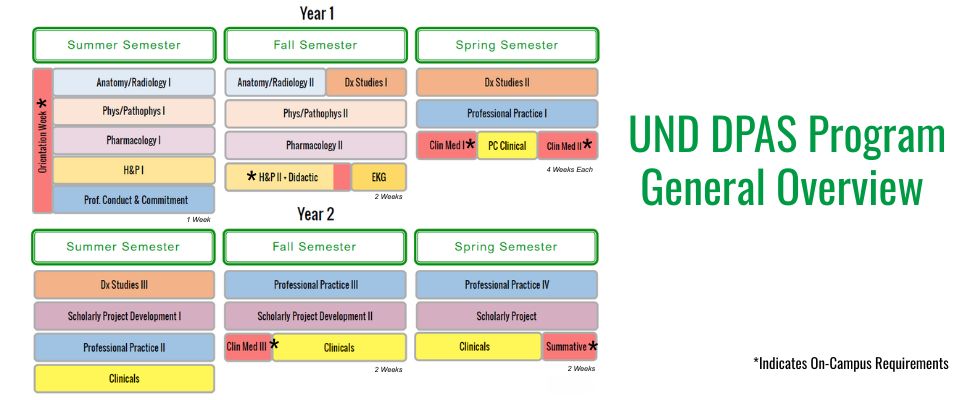Program Format
Innovative Program Design

The UND Physician Assistant Studies Master's Program is 24 months in length.
- The Program begins with an on-campus orientation in May. This is followed by a blended curriculum with on-campus and online components in the first two semesters of classroom instruction (referred to as didactic). The coursework for these semesters is primarily delivered on-line. There are synchronous online class sessions each week, regular times for online examinations, and a two-week on-campus didactic experience in the fall.
-
In January, the primary care course series begins. The student will experience rotating classroom instruction and clinical experiences in a sequential approach with three on-campus classroom sessions throughout the year. This instruction is followed by supervised clinical practice experiences in a longitudinal primary care clinical setting.
- Alternating classroom and clinical learning, where each content session is followed by a clinical practice experience, provides immediate application of concepts resulting in greater development and retention of clinical competencies. During this time the student also completes additional online courses in diagnostic studies, evidence-based medicine and professional issues.
- The final semester consists of 14 weeks of specialty clerkship or combination of primary care clinical rotations, completion of a scholarly project, and a final two weeks on campus for testing, review, and additional instruction on office practice and management.
-
During each clinical phase, a member of faculty communicates with the student/preceptor team to monitor specific areas of experience needed by the student to meet the educational goals of the Program and to facilitate role development. This is done by site visit, video conferencing and/or phone conference.
-
The Program is competency-based, which means that in order to graduate, each student must be able to demonstrate competencies in performing patient assessment and patient management functions, successfully complete comprehensive testing, and have completed a research project.
Courses by Semester (90 total credits)
PA 507: Medical Human Anatomy and Radiology I (3 cr.)
PA 510: Human Physiology and Pathophysiology I (4 cr.)
PA 512: History & Physical Exam I (2 cr.)
PA 517: Pharmacology I (2 cr.)
PA 565: Professional Conduct and Commitment (1 cr.)
Total: 12 cr.
PA 508: Medical Human Anatomy and Radiology II (3 cr.)
PA 511: Human Physiology and Pathophysiology II (4 cr.)
PA 513: History & Physical Exam II (2 cr.)
PA 516: EKG Interpretation (1 cr.)
PA 518: Pharmacology II (2 cr.)
PA 521: Diagnostic Studies I (2 cr.)
Total: 14 cr.
PA 522: Diagnostic Studies II (2 cr.)
PA 540: Clinical Medicine: Primary Care I - Didactic (5 cr.)
PA 541: Clinical Medicine: Primary Care I - Clinical (4 cr.)
PA 550: Clinical Medicine: Primary Care II - Didactic (5 cr.)
PA 566: Professional Practice (1 cr.)
Total: 17 cr.
PA 523: Diagnostic Studies III (2 cr.)
PA 525: Scholarly Project Development I (2 cr.)
PA 551: Clinical Medicine: Primary Care II - Clinical (4 cr.)
PA 567: Professional Practice II (1 cr.)
PA 570: Clinical Medicine - Primary Care Clinical Cont. (2 cr.)*
PA 571: Rural/Underserved Primary Care Clinical (3 cr.)*
Total: 14 cr.
* Course may be completed in other semesters.
PA 526: Scholarly Project Development II (2 cr.)
PA 560: Clinical Medicine: Primary Care III - Didactic (3 cr.)
PA 561: Clinical Medicine: Primary Care III - Clinical (3 cr.)
PA 568: Professional Practice III (1 cr.)
PA 570: Clinical Medicine - Primary Care Clinical Cont. (1 cr.)*
PA 580: Specialty Clerkship (4 cr)*
PA 583: Hospital Medicine Clerkship (2 cr)*
Total: 16 cr.
* Course may be completed in other semesters.
PA 569: Professional Practice IV (1 cr.)
PA 580: Specialty Clerkship (6 cr.)*
PA 581: Emergency Department Clerkship (4 cr.)*
PA 582: General Surgery Clerkship (4 cr.)*
PA 995: Scholarly Project (2 cr.)
Total: 17 cr.
* Course may be completed in other semesters.